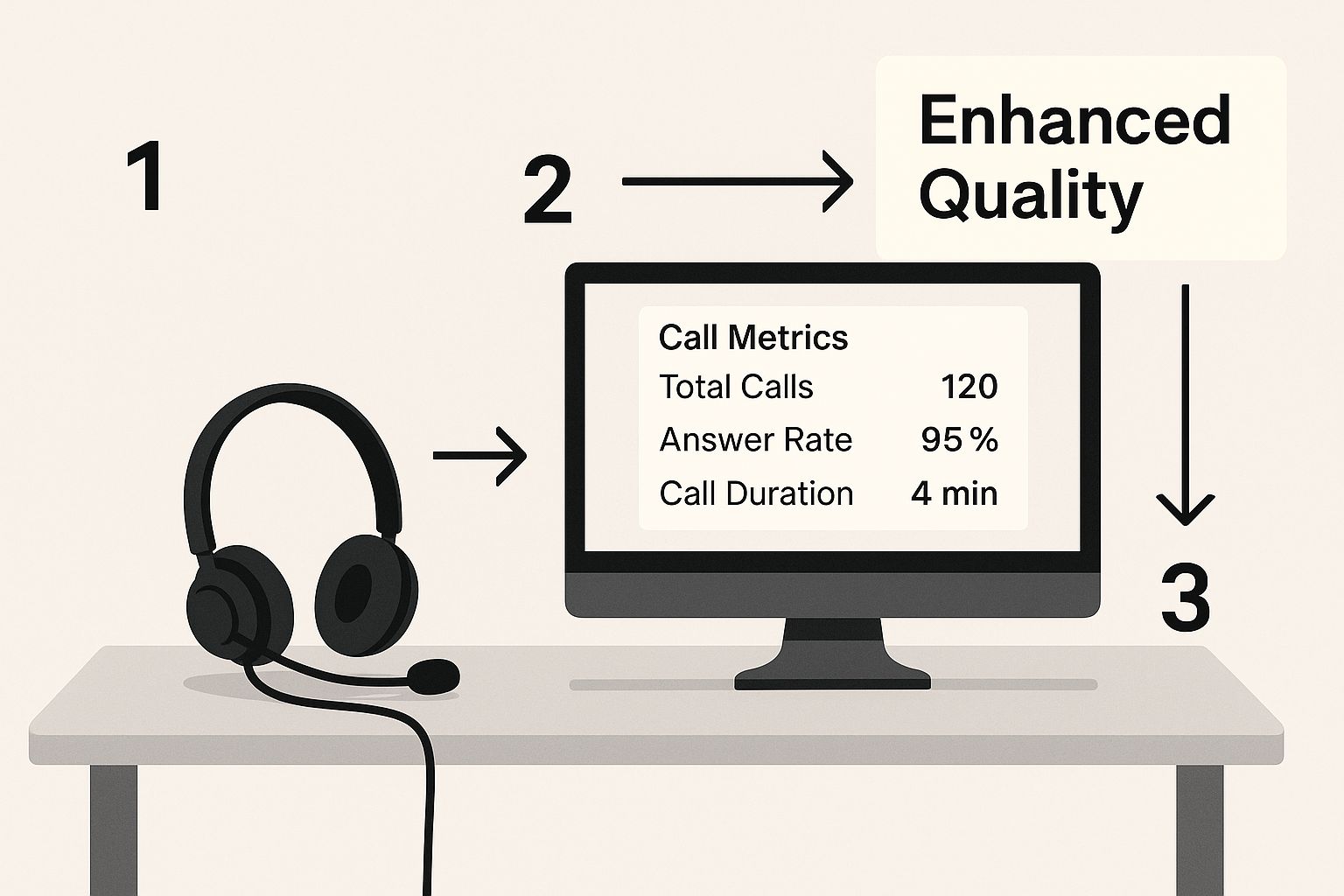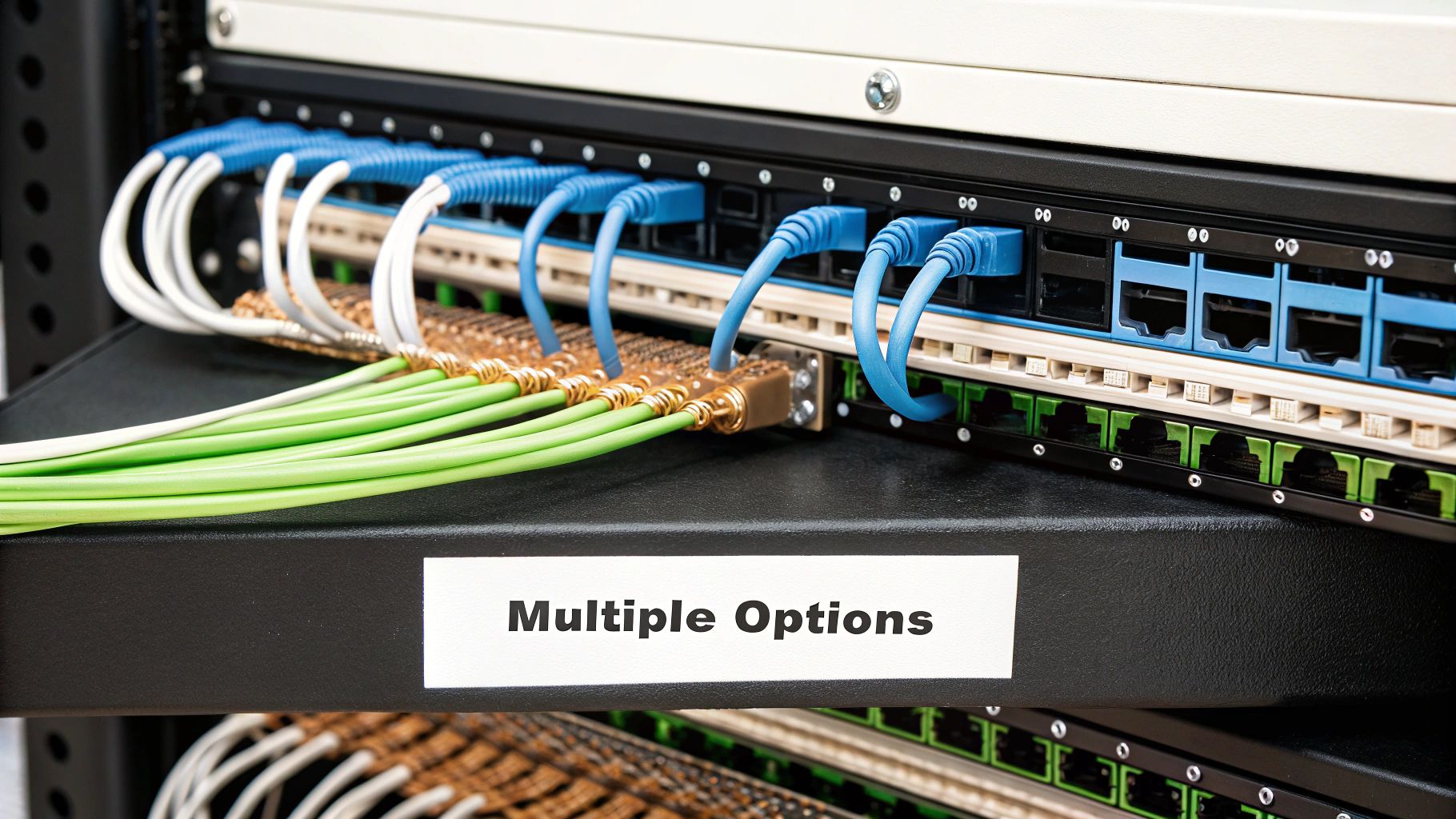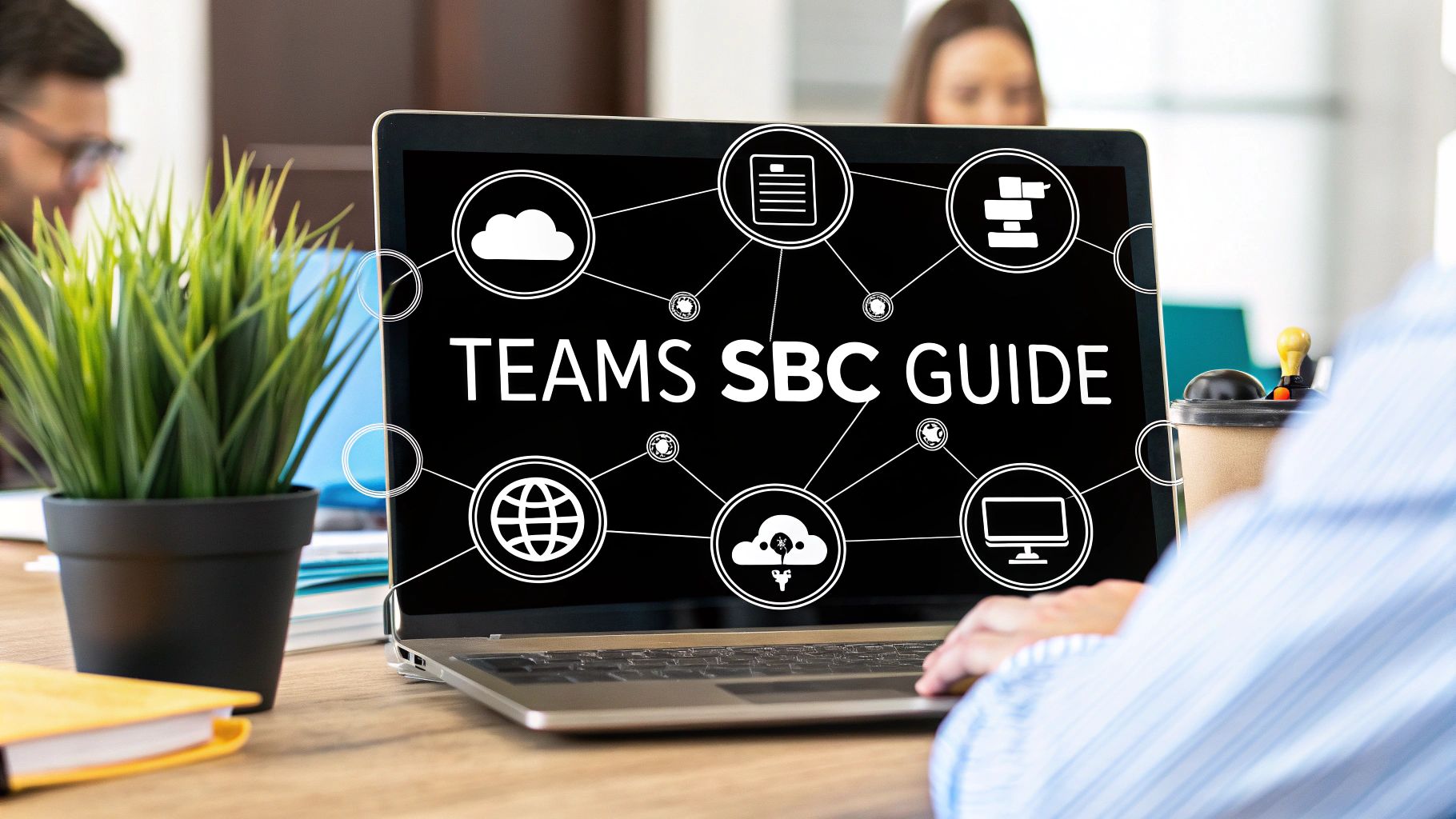Think of a Microsoft Teams SBC (Session Border Controller) as the sophisticated gatekeeper for your company's phone system. It's the essential piece of technology that connects your existing telephony setup—whether it's on-premise or from another provider—to the Microsoft Teams platform. Its main purpose is to enable 'Direct Routing' by skillfully managing the flow of voice traffic between these two distinct environments.
Breaking Down What a Microsoft Teams SBC Actually Does
At its heart, a Session Border Controller is a specialized firewall designed exclusively for voice. Your regular network firewall is great at protecting data, but an SBC stands guard at the very edge of your voice network. It inspects, directs, and secures every single call that travels between the public telephone network (PSTN) and your internal Microsoft Teams world.
This function became absolutely critical as businesses embraced modern communication tools. For instance, the Middle East and Africa region saw a massive spike in Teams adoption starting in 2020, with 8.6 million downloads in just a few months. This quick pivot to cloud-based platforms created an immediate need to integrate them with established phone systems—a job tailor-made for an SBC.
The Universal Translator for Voice
Imagine you need two people who speak completely different languages to have a seamless conversation. You'd hire a professional interpreter to translate everything in real-time, making sure not just the words, but the intent and nuance, come across perfectly. A Microsoft Teams SBC does exactly this for communication technology.
The traditional phone network (PSTN) and Microsoft Teams "speak" different technical languages (protocols) to set up and manage calls. The SBC is that indispensable interpreter.
- Protocol Interworking: It takes signaling from older systems (like ISDN) and translates it into the Session Initiation Protocol (SIP) that Teams requires.
- Codec Transcoding: It also converts different audio formats (codecs) on the fly, guaranteeing that the voice quality remains crisp and clear, no matter which network the call originates from.
This powerful translation is what lets an employee on a Teams call from their laptop have a perfectly normal conversation with a client on an old-school landline.
This diagram shows how an SBC is positioned right at the border, separating the trusted internal network from the public internet or an external SIP trunk provider.
What this model really highlights is the SBC’s strategic role as the official demarcation point. It controls all session traffic that comes into or leaves the business network.
To help clarify its role, here’s a quick summary of what an SBC handles.
Core Functions of a Microsoft Teams SBC at a Glance
This table summarizes the primary roles a Session Border Controller plays in enabling Microsoft Teams Direct Routing for your organization.
| Function | Description | Business Benefit |
|---|---|---|
| Security | Acts as a voice-aware firewall, protecting against threats like toll fraud, DoS attacks, and eavesdropping. | Prevents unauthorized access and financial loss, securing sensitive business conversations. |
| Interoperability | Translates between different signaling protocols (e.g., SIP, H.323) and audio codecs. | Enables seamless communication between Teams and virtually any other phone system or provider. |
| Session Management | Controls how calls are initiated, managed, and terminated, including routing and call admission control. | Ensures reliable call connections, manages network bandwidth, and maintains high-quality service. |
| Topology Hiding | Masks the internal network structure from the outside world. | Enhances security by making it difficult for attackers to map out and target your internal systems. |
As you can see, the SBC is much more than a simple connector; it’s a multi-talented device that ensures your communications are secure, reliable, and universally compatible.
The Security Guard for Your Phone System
Beyond translation, an SBC's most vital responsibility is security. By connecting your private voice network to the public internet, it becomes your first and most important line of defense against threats aimed specifically at voice communications.
An SBC protects your organization from common attacks like toll fraud, where attackers hijack your phone lines to make expensive international calls, and Denial of Service (DoS) attacks, which can flood your system and bring your communications to a halt.
It accomplishes this by hiding your internal network layout, encrypting call traffic, and applying strict rules about who can connect and when. This security layer is absolutely fundamental for protecting private business discussions and avoiding potentially massive financial losses. For a deeper look at making calls with Teams, explore our guide on Microsoft Teams Voice.
How Teams Direct Routing Architecture Works
To really get a handle on what a Microsoft Teams SBC does, it helps to follow the path a phone call takes. Picture the whole setup like a sophisticated, high-tech mailroom. A call coming from an outside line is like a package arriving from overseas; it needs to clear several checkpoints before it lands safely with its intended recipient—one of your employees on their Teams client.
It all starts when someone dials your business number from the Public Switched Telephone Network (PSTN), which is just the classic phone network we’ve all been using for decades. That call travels from the PSTN to your telecom provider. There, it's converted into a digital signal and sent over the internet using what's known as a SIP Trunk. Think of a SIP Trunk as a secure, multi-lane digital highway for your calls, completely replacing the need for old-school physical phone lines.
The SBC as the Central Hub
This is where your Session Border Controller (SBC) steps in. It acts as the central security checkpoint and sorting hub for every voice call that comes your way. As the call arrives from the SIP Trunk, the SBC gets to work, performing several critical tasks. It verifies the call's origin, confirms it isn't malicious, and—most importantly—translates its technical language (or protocol) into a format that Microsoft Teams can understand.
Once this translation and security screening is complete, the SBC routes the call over a secure connection to the Microsoft 365 cloud. From there, Microsoft’s Phone System takes over, directing the call to the right person, who can then answer it directly in their Teams app on a laptop, desk phone, or smartphone. The amazing part? This entire journey happens in milliseconds, making the experience seamless.
This flow shows how an SBC sits at the heart of your calling architecture, not just connecting the dots but actively managing call quality and security.

This process highlights the SBC's central role. It's not just a passive connector; it's an active manager ensuring every call is secure, clear, and reliable.
Essential Architectural Components
For this setup to work flawlessly, a few key pieces need to be in place. Each component has a specific job in creating a robust and high-performing communication system.
- Session Border Controller (SBC): This is the core component. It can be a physical box in your data center or, more commonly these days, a virtual machine hosted in the cloud. It’s the non-negotiable bridge between your telecom provider and the Microsoft Teams Phone System.
- SIP Trunks: These are the digital phone lines you get from a telecom carrier. They connect your SBC to the global PSTN, enabling all your inbound and outbound calls.
- Microsoft Phone System Licenses: To turn on voice capabilities in Teams, your users need the right Microsoft licenses. This is what "unlocks" the dial pad and other calling features within their Teams client.
This kind of infrastructure is fast becoming a standard for modern businesses. In fact, the Unified Communications as a Service (UCaaS) market in the UAE and the Middle East is projected to grow at a CAGR of 14.7% between 2023 and 2030, largely driven by the adoption of solutions like Teams Direct Routing. This growth isn't surprising—it reflects a clear demand for integrated tools that simplify company operations and allow businesses to get more value from their existing telephony investments.
The real beauty of the Direct Routing architecture is its flexibility. It lets a company stick with its preferred telecom carriers—often locking in better call rates and keeping its established phone numbers—all while moving to a modern, unified platform like Teams.
By understanding this call flow, it becomes much clearer how a Microsoft Teams SBC provides far more than just a connection. It delivers control, security, and resilience to your most critical business communications. To learn more about implementing this technology, you can dive into our comprehensive guide to Microsoft Teams.
The Real-World Benefits of a Teams SBC

The technical diagrams are great, but let's get down to what really matters. What's the business case? How does a Microsoft Teams SBC actually help your organization? It’s not just another box in the network closet; it's a strategic investment that pays real dividends in cost savings, operational agility, and security.
When you're migrating to a modern platform like Teams, the last thing you want to do is throw away years of investment in your existing phone systems or give up favorable carrier contracts. An SBC is the key that unlocks the door to a smarter, more cost-effective approach. It’s what lets you connect Teams to your existing telephony world through a method known as Direct Routing.
Drastically Reduce Telephony Costs
The most immediate and obvious win is the freedom to choose your own phone service provider. If you rely solely on Microsoft's Calling Plans, you might find yourself paying a premium, especially if your team makes a lot of calls. An SBC lets you "bring your own carrier," which is a game-changer.
You can stick with the provider you already have a great relationship with, keep the competitive rates you negotiated, or even shop the market for the best deals on local and international calls. For many companies, this single move can slash their monthly telecom spending. You're also able to funnel all your voice traffic through a central SIP trunk, getting rid of the expense and hassle of managing separate phone lines for every office.
- Keep Your Carrier: Don't abandon your trusted telecom provider and their negotiated rates.
- Optimize Call Rates: Take advantage of the competitive market to find the best prices, particularly for costly international calls.
- Consolidate Infrastructure: Simplify your setup by reducing the number of physical phone lines and hardware spread across your locations.
Ultimately, this puts you back in control. Your voice communication stops being a fixed, take-it-or-leave-it cost and becomes a flexible expense you can actively manage and optimize.
Gain Unmatched Operational Flexibility
Business doesn’t stand still. You might acquire another company, move to a new office, or transition to a hybrid work model. A Microsoft Teams SBC gives you the underlying flexibility to handle these shifts without ripping and replacing your entire communications setup.
Think about a company looking to finally retire an old on-premise PBX. An SBC makes this a smooth, controlled process. You can migrate users to Teams in manageable waves—maybe one department at a time—while the old and new systems work together perfectly in the background. No more high-stakes, big-bang cutovers that risk disrupting the entire business.
One of the biggest advantages here is how it supports a hybrid workforce. With an SBC and Direct Routing, you can give an employee their official business number on any device that runs Teams—their laptop at home, their smartphone on the road, or a traditional desk phone.
This is huge. It means your team always looks professional and stays connected, using a single, consistent business identity no matter where they are. They can work from anywhere without having to give out their personal mobile numbers for business calls.
Fortify Security and Ensure Compliance
In a world of ever-present cyber threats, locking down your voice communications is simply not optional. An SBC essentially acts as a highly specialized security guard for your voice network. It sits right at the edge, carefully inspecting every single call that comes in or goes out.
Bad actors are actively trying to exploit voice systems for financial gain or to cause chaos. We've seen recent campaigns from groups like Storm-2372 using fake Teams meeting invites in phishing attacks to hijack user accounts. An SBC is your first and best line of defense.
It effectively shields your network from common voice-specific attacks:
- Toll Fraud: This is where attackers break into your phone system to rack up enormous bills by making unauthorized international calls on your dime.
- Denial-of-Service (DoS) Attacks: Hackers can flood your system with junk traffic, making it impossible for you to make or receive legitimate calls and bringing business to a halt.
- Topology Hiding: The SBC acts like a curtain, hiding the layout of your internal network from the outside world. This makes it much harder for an attacker to map out your systems and find weak points.
By enforcing strong encryption and strict access policies, a Microsoft Teams SBC not only protects your confidential conversations but also helps you tick the boxes for regulatory compliance and data protection. It’s a foundational piece of any resilient, secure modern workplace.
Choosing Your SBC Deployment Model

When you decide to integrate a Microsoft Teams SBC, one of the first and most critical forks in the road is deciding where it will live. Will you host it yourself, on your own hardware in your data center? Or will you go with a cloud-hosted solution managed by an expert third party?
This choice between on-premises and the cloud is far more than just a technical detail. It fundamentally shapes your costs, how much your IT team has on its plate, and how quickly you can adapt to business changes.
Each approach has its own clear advantages, and the right fit really depends on your organization's DNA. A large enterprise with a deep bench of IT pros and strict data residency rules might lean toward the absolute control of an on-premises setup. On the other hand, a growing business that needs to stay nimble will likely find the simplicity and scale of a cloud service much more attractive.
Let's unpack both options so you can see which path makes the most sense for you.
On-Premises SBC Deployment
Going the on-premises route for your Microsoft Teams SBC means you buy and install either a physical appliance or a virtual one right inside your own IT environment.
Think of it as owning your own house. You're responsible for everything—the foundation, the roof, the security system, and all the maintenance that comes with it. This model gives you the final say on every single aspect of the system. Your team manages the hardware, rolls out software updates, fine-tunes security policies, and handles every bit of troubleshooting.
- Complete Control: You have direct, hands-on access to the hardware and software, which is perfect for deep customizations and integrations with your other on-site systems.
- One-Time Capital Expense: The main cost is the upfront purchase of the appliance. This is a capital expenditure (CapEx), not a recurring operational bill.
- Data Sovereignty: All your voice traffic and call data stay safely behind your own firewall. This is often a non-negotiable requirement for businesses in finance, healthcare, or government.
But with great control comes great responsibility. This path demands you have people on your team with specialized skills in both telephony and network security to keep things running smoothly and securely.
Cloud-Based SBC Deployment (SBCaaS)
The alternative is the cloud-based model, which you'll often hear called SBC as a Service (SBCaaS). Here, you subscribe to an SBC service from a specialized provider, like Cloud Move. The provider owns, operates, and maintains all the complex SBC infrastructure in their own secure, geographically distributed data centers.
This is much more like renting a fully serviced apartment. You get a fantastic place to live without ever worrying about the plumbing, wiring, or building security—the landlord takes care of all of that.
With SBCaaS, you move from a capital-heavy (CapEx) model to a predictable operational expense (OpEx) model. A large, one-time hardware cost is replaced by a manageable monthly or annual subscription fee.
This approach is a game-changer for businesses that need to move fast and want to offload the headache of managing complex infrastructure. It frees your IT team from the constant cycle of patching, updating, and securing hardware, letting them focus on bigger, more strategic projects that drive the business forward.
Head-to-Head Deployment Comparison
To help you visualize the trade-offs, let's put the two models side-by-side. The following table breaks down the key differences to help you align your budget, resources, and business goals with the right deployment model.
Cloud vs On-Premises SBC Deployment Comparison
A detailed comparison to help you choose the right SBC deployment model for your organization's needs.
| Criterion | Cloud-Based SBC (SBCaaS) | On-Premises SBC |
|---|---|---|
| Initial Cost | Low (Minimal to no upfront hardware costs) | High (Requires significant capital investment for hardware/software) |
| Ongoing Costs | Predictable subscription fees (OpEx) | Variable (Power, cooling, maintenance, staff time) |
| Management | Managed by the provider; you control routing policies | Managed entirely by your in-house IT team |
| Scalability | High (Easily scale up or down based on demand) | Limited (Requires purchasing new hardware to scale) |
| Expertise | Requires minimal in-house telecom expertise | Demands specialized IT staff for management and security |
| Implementation | Fast (Provider handles the core setup) | Slower (Requires physical installation and configuration) |
So, which is it? The truth is, the "right" choice is entirely personal to your organization. If you have the capital to invest, the in-house talent to manage it, and a business need for absolute control, an on-premises Microsoft Teams SBC is a robust and reliable option.
However, if your priorities are speed, flexibility, and cost-efficiency, a cloud-based SBCaaS solution offers a compelling, modern, and often smarter path to enabling Direct Routing.
How to Select the Right SBC Vendor and Partner
Choosing the right technology is only half the battle. Your project's success hinges just as much on the vendor who builds the Microsoft Teams SBC and the partner who helps you implement it. This isn't just a simple purchase; it's about forging a partnership that guarantees a smooth deployment and long-term value.
Making a poor choice here can lead to a cascade of frustrating technical issues, unexpected costs, and a system that just doesn't deliver. A great vendor and partner, on the other hand, act as strategic allies. They’ll guide you through the maze of telecom integration and help you get the most out of your investment in Microsoft Teams Voice.
Key Criteria for Evaluating SBC Vendors
Not all SBCs are built the same. Before you make any commitments, you need to vet potential vendors against a tough set of criteria. The goal is to find a product that is not only powerful and secure but also officially blessed by Microsoft for Direct Routing.
Start with the must-haves:
- Official Microsoft Certification: This is non-negotiable. A certified SBC has been put through the wringer by Microsoft, ensuring it meets their strict standards for performance, security, and interoperability within the Teams world.
- Proven Performance: Ask for hard numbers. Look for vendors who can back up their claims with clear benchmarks and real-world case studies. How many simultaneous calls can their SBC handle? What's their uptime record?
- Robust Security Features: Your vendor should offer advanced security, including encryption, topology hiding, and solid defenses against toll fraud and Denial of Service (DoS) attacks.
- Seamless Interoperability: An SBC needs to talk to more than just the PSTN. Check if it can integrate with other critical systems, like your analog devices (think fax machines or elevator phones) or third-party contact center platforms.
The right SBC vendor provides more than hardware or software; they provide a foundation of trust. Their certification and security features are your assurance that your voice communications are protected and will work seamlessly with Teams today and in the future.
What to Look for in an Implementation Partner
The partner you choose to design and deploy your solution is just as crucial as the SBC vendor. An experienced partner can be the difference between a seamless transition and a project bogged down by delays and technical headaches. They are your guide from start to finish.
When you're sizing up potential partners, look for these qualities:
- Verifiable Experience: Don't just take their word for it. Ask for concrete examples of successful Teams Voice and Direct Routing projects they've handled for businesses similar to yours in size and scope.
- Deep Telecom Knowledge: The partner must have a solid grip on local and regional telecom regulations. They also need a deep understanding of how to configure systems like IP SIP Trunking for optimal performance.
- Comprehensive Support: What happens after the launch? A great partner offers strong support plans, ongoing monitoring, and proactive maintenance to keep your system stable and secure.
This focus on partnership is especially critical given the explosive growth of Teams. Globally, daily active users shot up by 475% in just over a year, and the UAE has been a big part of that wave. This boom created a huge demand for skilled partners who could correctly integrate a Microsoft Teams SBC, bridging the gap between legacy phone systems and the modern workplace. You can find more on these trends at Condeco's blog on Teams adoption.
Ultimately, your selection process needs to be a balanced look at both the technology and the expertise behind it. By picking a certified vendor and a skilled partner, you’re setting your organization up for a successful, secure, and future-proof communications strategy.
Common Questions About Microsoft Teams SBCs
When businesses start looking into a Microsoft Teams SBC integration, the same practical questions always pop up. It's a big move, so it's only natural for IT and business leaders to have concerns about the cost, complexity, and how it will all fit together. Let's walk through some of the most common queries we hear and give you some clear, straightforward answers.
Most of these questions boil down to the best way to roll it out, how Direct Routing stacks up against other options, and making sure no critical communication tools get left behind in the process.
Do I Really Need an SBC for Every Office Location?
Thankfully, no. In fact, one of the biggest wins of a modern voice setup is centralization. You can set up a single, central Microsoft Teams SBC—either in your main data center or, more commonly, as a cloud service—and have it handle calls for all your offices and even your remote employees.
This approach makes management so much simpler. It cuts down on hardware and maintenance overhead and gives you one central point of control for your entire voice network. The only time you might think about a decentralized model is if you're a massive, globe-spanning company with specific carrier needs in different regions that demand extra local resilience.
What Is the Difference Between Direct Routing and Calling Plans?
I like to think of it this way: it’s the difference between bringing your own lunch to work versus buying it from the company cafeteria.
Calling Plans are Microsoft’s all-in-one offering. You get your phone numbers and calling minutes straight from them. It’s incredibly simple and fast to get going, but that convenience usually comes with a higher price tag and less flexibility.
Direct Routing, on the other hand, requires an SBC and lets you "bring your own carrier" into the Teams environment. This is where you get real freedom—the power to negotiate better rates, keep your long-held phone numbers, and stick with your trusted local providers like Etisalat or du. The SBC is the key piece of technology that unlocks these major cost savings and operational advantages.
Can I Connect My Old Analog Devices?
Absolutely. This is one of the most critical and often overlooked benefits of using a certified Microsoft Teams SBC. Nearly every business has essential analog devices that can't just be swapped out for a modern equivalent, such as:
- Fax machines
- Elevator emergency phones
- Door entry systems
- Warehouse paging systems
An SBC can interface with an Analog Telephone Adapter (ATA), a neat little device that translates the old analog signal into a digital one that Teams can work with. This means you can fully modernize your core communication platform without having to rip and replace essential legacy hardware, saving you from a costly and disruptive headache.
Ready to unlock the full potential of Microsoft Teams Voice with a secure, flexible, and cost-effective Direct Routing solution? Cloud Move provides expert deployment of Microsoft Teams SBCs, tailored to your business needs. Request your free demo today and see how we can streamline your communications.




